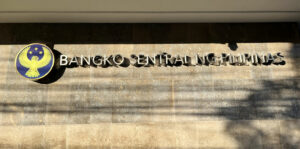By Keisha B. Ta-asan, Reporter
BANGKO SENTRAL ng Pilipinas (BSP) Governor Eli M. Remolona, Jr. said it is premature to discuss policy easing in 2024, with the Monetary Board still prepared to hike borrowing costs if needed to make sure inflation returns to the 2-4% target range.
“The risks are still there so we have to assess the situation. I think it’s premature to say we will start to ease,” he told reporters on Wednesday evening.
Mr. Remolona said the BSP remains hawkish as frequent supply shocks could lead to higher inflation expectations and second-round effects.
“We want to be sure (inflation) stays within the target range, comfortably within the target range, and then when we are comfortable about that, we can start to think about easing,” he said.
“If inflation is within the target range for one month, it’s not enough. It has to be there and it has to look like it will stay there until we can start to consider not being hawkish,” he said.
The BSP chief said the goal is to keep inflation expectations anchored to mitigate second-round effects.
Headline inflation slowed for a second straight month in November to 4.1%, its lowest in 20 months. Year to date, inflation averaged 6.2%, still above the central bank’s 6% forecast.
From May 2022 to October this year, the BSP has raised interest rates by 450 basis points (bps), bringing the benchmark interest rate to a 16-year high of 6.5%.
Mr. Remolona also said there will be no cut in banks’ reserve requirement ratio (RRR) while the central bank remains hawkish.
The RRR for big banks is currently at 9.5%, while the ratio for digital banks is at 6%. The BSP also set the RRR for thrift banks, and rural and cooperative banks to 2% and 1%, respectively.
Despite the aggressive rate increases since last year, Mr. Remolona noted Philippine economic growth is still very strong and robust. He noted the impact of policy tightening is gradual, with the effects taking some time to materialize due to prolonged lags.
“We wish (the lags) were shorter,” he said. “We have to improve the transmission mechanism of monetary policy.”
Mr. Remolona also said the central bank does not want to make any unnecessary tightening.
“We want to make just enough tightening so that we get within the target range and expectations remain anchored to our target,” he said.
However, monetary policy may be kept tighter for longer since inflation may go up again next year.
“It’s sort of tricky because we think inflation should be within the (2-4%) target range in the next month or so, and then there’s kind of a base effect then it will go up and maybe exceed the target range (again),” Mr. Remolona said. “Hopefully not, we hope we could settle within the target range for the rest of 2024.”
In early 2024, he noted inflation may ease to below 3% before picking up again to 4% by midyear.
At its November meeting, the BSP lowered its risk-adjusted inflation forecast for 2023 to 6.1% (from 6.2%), to 4.4% (from 4.7%) for 2024, and to 3.4% (from 3.5%) for 2025.
On the other hand, the BSP’s baseline inflation forecast stood at 6% in 2023 and at 3.7% in 2024, before easing to 3.2% in 2025.
Moving forward, Mr. Remolona said the BSP will use the risk-adjusted inflation forecast and emphasized that policy will be based on “likely events.”
Meanwhile, HSBC economist for ASEAN Aris Dacanay in a note said the BSP will keep its policy rate steady on Dec. 14 after inflation eased in November.
“All in all, the economy’s macroeconomic fundamentals are improving and there is no impending need to adjust monetary policy to be even more restrictive,” he said.
However, inflation may rise again and breach the 2-4% target in the second quarter of next year when the tariff rates for agricultural items could increase due to the expiration of Executive Order No. 10 on Dec. 31.
“With upside risks to inflation still heavily tilted to the upside, it may still be too early to put rate cuts on the table. The economy will need time to pause, to ensure that the BSP’s tight monetary stance filters through to the economy,” Mr. Dacanay said.
The BSP may also begin its easing cycle gradually after the US Federal Reserve does its first rate cut within the third quarter of 2024.
“By then, we expect headline CPI to be softening on a consistent basis. Cutting at the same rate as the Fed will also mitigate the volatility of the peso against the dollar given how wide the current account deficit still is for the Philippine economy,” Mr. Dacanay said.
The BSP projects the current account deficit to reach $11.1 billion, or equivalent to -2.5% of gross domestic product (GDP).
In the first semester, the current account deficit stood at $8.2 billion (-4% of GDP), 32.2% lower than the $12.1 billion deficit (-6.1% of GDP) a year ago.
